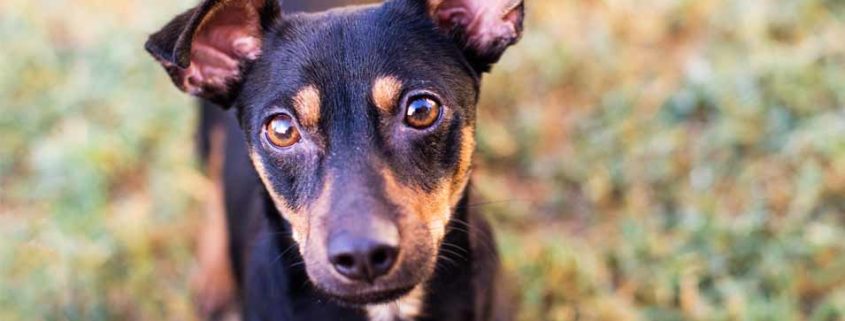More and more people are concerned about the effects items in their home environment may have on their dogs. From foods stocked in the kitchen for the family to enjoy to cleaners purchased to keep the house looking spic and span, owners ponder just how safe these items are when it comes to Fido and his health. But things that can grow organically in the home under the right conditions may pose the greatest risk of all. One of the most serious issues that can invade a home is toxic mold, leaving many owners wondering just how dangerous toxic mold is to dogs and what can be done to get rid of it.
What Makes Mold Dangerous?
Though there are many different types of molds, there are only a few that are potentially toxic to dogs. The most dangerous type of mold is called toxic black mold. Its presence in a dog’s living environment can result in serious illness and fatalities in both people and their pets.
Toxic black mold is particularly dangerous because it enters the dog’s system through its breath. This means that if a dog spends any amount of time in an area where mold is found, the dog will inhale the spores, beginning the process of contamination.
Mold typically favours dark areas of the home where moisture and heat are trapped. This means that places where flooding occurs are the ideal environment for toxic black mold to thrive. At times, the mold is easily seen by the naked eye, but it is important for families to note that mold can also be present in places that are not visible such as within walls and underneath flooring.
What are the Symptoms of Black Mold Toxicity in Dogs?
Toxic black mold is one of the most potent species in the mold family. This type of mold emits chemicals known as mycotoxins that affect dogs on the cellular level, leading to the death of vital healthy cells and the possibility of irreparable liver damage. Since black mold enters the system through inhalation, there is a high possibility of dogs will develop pulmonary hemorrhage, a painful condition in which bleeding of the lungs occurs.
In order for a dog suffering from black mold toxicity to have the best chance of recovery, immediate treatment is critical. Damage to both the organs and nervous system can occur very rapidly, and unfortunately, cannot be repaired.
Among the most common symptoms dogs suffering from toxic mold will exhibit include:
- Wheezing or coughing
- Respiratory distress
- Nose bleeds
- Pulmonary hemorrhage
- Excessive scratching
- Chewing of the skin
- Excessive licking
- Extreme fatigue
- Nasal discharge
- Poor appetite
Though most pets become affected by mold through inhalation, molds can also be ingested. This most commonly happens when dogs eat foods that have become rotten. Certain food items such as soft cheeses and sour cream begin to emit dangerous chemicals which can lead to accidental poisoning. The most common signs of mold poisoning brought on by eating spoiled food include body tremors or spasms.
However, sometimes, dogs will exhibit signs of what may appear to be toxic mold poisoning, but instead are actually symptoms of allergies. To help determine the root cause behind a dog’s discomfort, it is a good idea to visit a veterinarian for a wellness exam and thorough assessment.
Though many families are aware of the dangers of black mold, what they don’t realize is that there are over 10,000 different types of mold, making it very difficult for a novice to determine precisely which kind is affecting their home. Since molds are very difficult for a homeowner to identify, it is recommended that a mold remediation expert make a visit to the home to help determine what type of mold is in the house and develop the best plan to safely remove it.
What Causes Mold to Develop?
There are many different reasons why mold may develop inside a house. Since mold prospers in an environment that is dark, moist, and warm, mold can begin to accumulate as a result of high amounts of condensation, excessive humidity indoors, leaking pipes, or as the after effect of flooding. Most homes do have moisture problems to varying degrees. Since mold spreads very quickly within the right environment, it is important to put measures in place to keep the home as dry as possible.
Identifying the conditions in which mold can thrive is a critical part of a strategy to keep a home free from this potentially toxic substance. Here are several areas in which mold can thrive:
- Household clutter
Keeping airflow moving in an unobstructed fashion through home heating systems, ventilation, and air conditioning units is critical to preventing the development of mold. When this occurs, condensation can begin to accumulate, a condition that encourages the growth of mold.
- Humid areas
Any area in a home that is prone to humidity is a ripe breeding ground for mold. These rooms should have fans installed to help draw steam from the environment.
- Dripping water
Windows that are frequently clouded with condensation or pipes that leak water can easily lead to the accumulation of mold on their exterior.
- Refrigerator drip pan
Drip pans found in refrigerators can begin to collect water that becomes the ideal environment for mold growth.
How Can I Get Rid of Black Mold in my House?
If a homeowner suspects their house may be infected with black mold, it is critical that they call a professional mold remediation company immediately. Mold specialists possess the skill to safely remove all traces of harmful mold from a home, ensuring the safety of those that dwell within it. Since mold easily travels through spores, it is quite easy for mold to spread throughout a home like wildlife, meaning its eradication is a job best left to the professionals.
Since toxic black mold can harm both humans and pets, it is vital that specialized equipment and personal protection gear be worn to prevent the inhalation of any mold spores during the cleaning process.
How Can I Protect My Dog from Mold?
There are several things homeowners can do to help keep their pets safe from mold. These include:
- Sealing pet food in containers and storing them in cool, dry areas
- Washing food and water bowls daily
- Washing pet toys at least once weekly
- Washing pet bedding often, making use of hot water
- Cleaning all crates regularly
- Restricting access to areas where high mold may occur such as basements, swamps, flooded regions
- Eliminating access to trash and/or spoiled food
- Performing regular mold inspections in the home
- Being proactive by preventing mold development
- Cleaning any traces of mold thoroughly and immediately
Worried your home may contain mold that could harm your pets? Consider hiring a mold remediation expert to help you get your home back in tip top shape.





Leave a Reply
Want to join the discussion?Feel free to contribute!